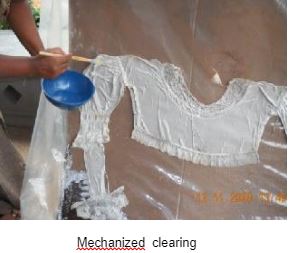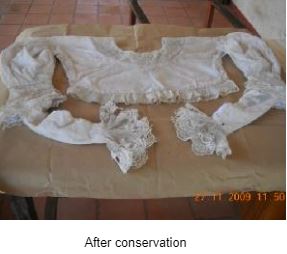Chemical Conservations
Application of chemical and physical treatment to ancient paintings, sculpture and artifacts in order to minimize their deterioration due to natural or other causes, is the major role of the Chemical Conservation Division of the Department of Archaeology. By such treatment, it is expected to prolong the lifespan of ancient paintings, sculpture and artifacts and preserve them for posterity.
Although the Department of Archaeology of Sri Lanka was established in 1890, it had no Chemical Conservation Division until 1940s. During the early part of 1940s, there was a risk of the world famous Sigiriya cave paintings being discoloured and loosen its plastering. At that time, there was no expert in the island to take remedial measures. Hence Mr. Khan Bahadur Mohamed Sana Ulla, the chemist of the Indian Archaeological Department came to the island on 27th January 1943 and preserved Sigiriya cave paintings. He trained Mr. P. Don Ambrose in chemical conservation work and thus the Department of Archaeology gained ground for chemical conservation work.
After retirement from the Department of Archaeology in India Mr. Khan Bahadur Mohamed Sana Ulla came to Sri Lanka once again on 13th April 1947 and attended conservation of murals in the country, until August of that year. He played a major role in the conservation of Thivanka Pilima Geya in Polonnaruwa. He contributed immensely towards the conservation of mural paintings in the country taking special conservation measures at Lankathilaka Pilima Geya and Gal Vihara in Polonnaruwa in addition to other places such as Pulligoda and Hindagala.
The Department of Archaeology recruited a chemist for the first time on 1st of November, 1949 for carrying out conservation work. Mr. R.H. De Silva who has been recruited to the Conservation Division of the Department as an Apprentice Chemist received a training at Deradun in India under the Indian Archaeological Chemist.
In 1950, the plastering of Sigiriya cave paintings again got weakened and began to fall. Mr. Sarath Wattala, Draughtsman of the Department who had experience in working under Mr. Sana’ Ula was able to take remedial measures.
For the first time in 1953, a conservation laboratory was established in a building at the Music and Dancing Institute, Colombo. During the decades of 1950s and 1960s, the laboratory gradually advanced into high position and in addition to conservation of paintings, widened its activities into various spheres such as control of fungus and weeds in ancient monuments, strengthening of plastering, conservation of antiquities, conducting research and experiments for new conservation methods and manufacturing plastic replicas of inscriptions. The Conservation Laboratory was shifted to the modern laboratory building within the head office premises in Colombo in the early 1970s.
The night of 14th October 1967 was the most challenging night of the department history. That night, a vandal had destroyed the world famous Sigiriya painting by applying paint on them. This incident shocked the entire world. Restoration of the frescoes was a serious challenge to be taken over by the conservation Division of the Department. The conservation team headed by Dr. R.H.De Silva attended to the restoration work with great effort under the guidance of Italian expert Mr. Luciano Marency. Possibility of restoring and preserving the Sigiriya rock paintings for posterity was a triumphant victory of the Chemical Conservation division.
Role of the Chemical Conservation Division
Restoring the destroyed Sigiriya frescoes
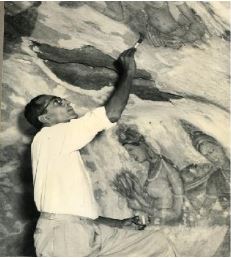
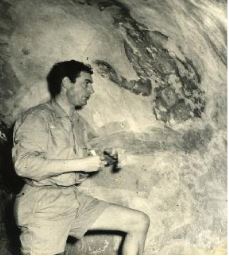

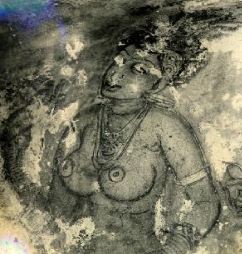
Conservation of a Thousand Years Old Ferry
The Department of Archaeology received information in 1992, from the villagers of Lathpandura, Palindanuwara in the Kalutara District of the Western Province, Sri Lanka that an ancient wooden ferry was found in a stream of the area. Mr. Iyen Goffrey, an expert conservationist of the Western Australian Museum came to Sri Lanka and examined the ferry in collaboration with Dr. Senarath Dissanayake, the then Assistant Director of the Exploration Division and the present Director General of Archaeology and prepared a conservation quality report and an estimate. A carbon 14 test proved that the ferry was approximately 960 years old. As a result of its removal from the water, it got dried and started to crack heavily. The Chemical Conservation Division launched a special project to conserve it by means of chemical treatment. It is now being prepared for public exhibition.
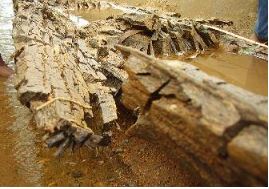
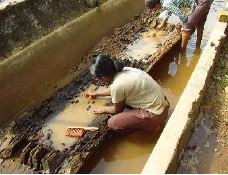
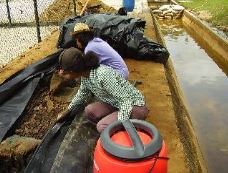

Another wooden ferry after Conservation
This was discovered in the Attanagalle Oya in March, 1998, in the Gampaha district of the Western Province. A carbon dating test performed by the Beta Analysis Organization, USA, proved that it was 1270 years old. It lay in water tank within the National Museum premises until its conservation bagan in 2008 under the Sri Lanka Netherland Cultural Cooperation Project. It was decided to be conserved in controlled environments, by air drying using wood powder. This method that doesn't use any chemical to avoid contraction, is a traditional one. To stop the growth of micro organisms, Boric acid and Borex were used. Whole wood powder saves money, the slow air drying prevents the amount of contraction as the wood dries up. The rate of contraction is continuously observed by the Department. Currently it is being prepared to be exhibited to the public.

Conservation of the Ancient Artillery
In the year 2007, a group of fishermen who had gone to catch sea leeches discovered a copper mixed metal with technological features supposed to be belonged to the Portuguese period and while they were transporting it. Mundalama Police in Puttalam had taken it into custody and handed over to the Department of Archaeology. According to the opinion of Lieutenant Commodeor Somasiri Devendra as mentioned in page 140 of the 1976 book, the fact that it belongs to Portuguese period has been well established. The artillery has been found at a place in the sea about 15Km away from Mundalama sea beach in western Sri Lanka. It was kept in the Puttalam museum premises for several months and it was brought to Colombo Museum premises for chemical conservation. Funds for conservation were provided by the Ministry of Cultural Affairs under Sri Lanka - Netherland Cooperation Project. After conservation, this has been well placed in the Marine Archaeological museum in the Dutch building inside the Galle Fort for public view.
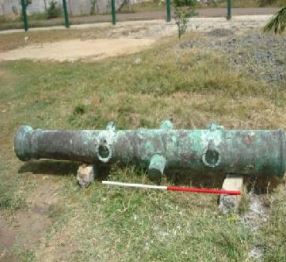
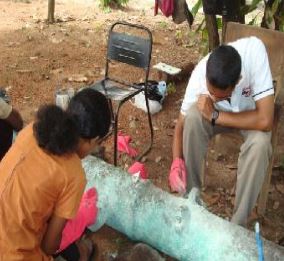
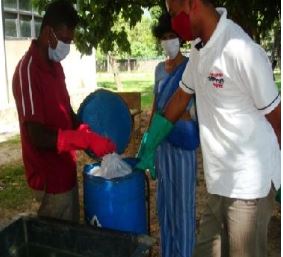

Conservation of Buddha Statue at Ovagiriya
Ovagiriya archaeological site is in Ampara District in the Eastern Province of Sri Lanka. This ruined site was explored and discovered by the Department of Archaeology on request of the Gal Oya Development Board. Most of the ruins had been destroyed by the operation of tractors of the Gal Oya Development scheme. Ruins of a stupa, an image house, capital of stone pillars, guard stones, Korawak gal, flat tiles, etc. are scattered all over the site. The Chemical Conservation Division of the Department of Archaeology commenced conservation of the headless and handless Buddha statue of 11 ½ feet in height, in the year 2008. At the time of commencement of conservation, the shoulder portion of the statue was broken and fallen, on the ground. It was lifted and kept in the standing position with the help of a wooden frame and a lever.

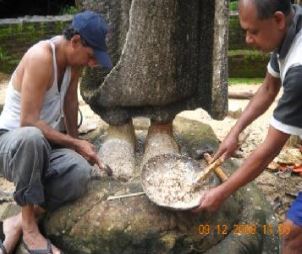
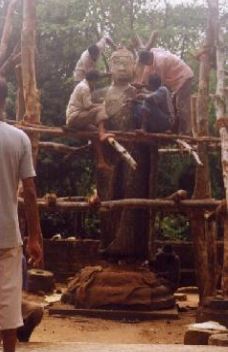

Ancient Fashions to the Modern Society
Chemical Conservation Division has started an ancient dress conservation project with the objective of providing opportunities to future generation to see dresses and fashions of the ancient society. As a first step of this project, several “kabakuruththu” dresses exhibited at E.W. Perera Memorial Museum at Kotte have been brought under conservation. “kabakuruththa” means a kind of dress worn by the middle class women lived in coastal areas during the Portuguese period to cover upper part of their body. It was type of short jacket with long sleeves made of white cotton cloth. It has a lace border around its neck. Wrists and the waist to look it more beautiful. Front portion and the back portion of the jacket was cut according to the required size from a single cloth. Even after the Portuguese period this dress style was popular among the women in coastal areas, particularly in Southern region during the Dutch period as well as the British period. At present it is used in certain areas of the South.

